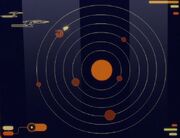(+nl) |
mNo edit summary |
||
| (48 intermediate revisions by 12 users not shown) | |||
| Line 1: | Line 1: | ||
| − | [[File: |
+ | [[File:Mixtus III orbital graphic.jpg|thumb|Two dimensional representation of the moons orbiting a planet]] |
| − | [[File: |
+ | [[File:Lima Sierra system.jpg|thumb|The orbital path for the four planets of the Lima Sierra system]] |
| − | [[File: |
+ | [[File:USS Enterprise orbiting Earth Two, remastered.jpg|thumb|The ''Enterprise'' in orbit of Earth Two]] |
| + | [[File:Terok Nor orbiting Bajor.jpg|thumb|Terok Nor orbiting Bajor]] |
||
| − | '''Orbit''' is a term used to describe the flight path of an object in [[space]] which has a repetitive motion and has a distinct center with respect to its flightpath. |
||
| + | '''Orbit''' was a term used to describe the movement of an object in [[space]] which had a repetitive pattern with a distinct center with respect to its [[flight path]]. This directly referred to such natural examples as a [[moon]] orbiting a [[planet]], to the same planet orbiting a [[star]], and so forth. ({{ENT|The Andorian Incident}}; {{TNG|Force of Nature}}) The general failure of an object to maintain its orbit was referred to as having a [[decaying orbit]]. ({{TOS|The Naked Time|The Galileo Seven}}; {{TNG|Symbiosis|Deja Q}}, et al.) To enter orbit in the event of an emergency was referred to as a [[emergency orbit]]. ({{TAS|Beyond the Farthest Star}}; {{TNG|Legacy}}) When a ship left orbit it was generally termed as "break(ing) orbit". ({{ENT|Minefield}}; {{TNG|The Arsenal of Freedom}}, et al.) |
||
| + | According to [[Captain]] [[James T. Kirk]], a starship "''can be maintained in orbit for several [[month]]s [..] with [[automatic controls]].''" ({{TOS|This Side of Paradise}}) |
||
| − | A [[starship]] uses a form of orbit to maintain its relative position. The term orbit is also used to define the flight path of a [[planet]] within its own [[star system]]. ({{TNG|Force of Nature}}) |
||
| + | For example, according to [[Neelix]], before the [[22nd century]], the [[Great Wall of China]] "''was one of the only [[Human|manmade]] objects that could be seen from [[Earth]]'s orbit with the naked [[eye]].''" As well, another one of the objects that could be seen from orbit was the [[Millennium Gate]], which was constructed in the early [[21st century]]. ({{VOY|11:59}}) |
||
| − | In [[2269]], [[Spock]] detailed to [[Abraham Lincoln]] that the {{USS|Enterprise|NCC-1701}} was 643 miles, 2,021 feet, 2.04 inches above the surface of [[Excalbia]]. ({{TOS|The Savage Curtain}}) |
||
| + | Earth's orbit around [[Sol|the sun]] was approximately 200,000,000 [[kilometer]]s, which was roughly same [[diameter]] of the [[Dyson sphere]] encountered by the {{USS|Enterprise|NCC-1701-D|-D}} in [[2369]]. ({{TNG|Relics}}) |
||
| − | There are several forms of orbit; some of them are referred to by [[Starfleet]] personnel with names like "standard orbit" or "high orbit." |
||
| + | In [[2267]], the orbit of [[Gamma Hydra IV]] carried the planet directly through the path of a [[rogue comet]]'s trail. ({{TOS|The Deadly Years}}) |
||
| − | *'''[[Synchronous orbit]]''': This form is used by a starship to maintain position towards a specific point on a planet's surface. The ship's velocity will be the same as the rotation speed of the planet. ({{TNG|Relics}}) |
||
| − | *'''High orbit''': A form of orbit in which the starship maintains a large distance from the planet's surface for safety reasons but is still close enough to use the [[transporter]]. ({{VOY|Ex Post Facto|The Omega Directive}}) The {{USS|Voyager}} parked in high orbit over [[Earth]], when it visited the planet in [[1996]], at an altitude of 20,000 kilometers. ({{VOY|Future's End}}) |
||
| − | *'''Polar orbit''': A type of spacecraft orbit that passes within 22,300 miles of the geographic poles of a planet. An image of the ''[[Nimbus 1]]'' [[artificial satellite|satellite]] in polar orbit of [[Earth]] was seen in the [[USS Enterprise (NCC-1701) library computer|USS ''Enterprise'' library computer]]. ({{TOS|The Cage}}) A polar orbit may also be used as an [[Evasive maneuvers|evasive maneuver]], since [[Electromagnetism|electromagnetic]] interference from a planet's magnetic pole may disrupt starship [[sensor]]s. ({{TNG|The Hunted}}) |
||
| + | The same year, the [[shock wave|shock]] caused by the explosion of [[Ceti Alpha VI]] caused the orbit of [[Ceti Alpha V]] to shift and everything on the planet was laid to waste. ({{film|2}}) |
||
| − | {{bginfo|It is safe to assume that standard and high orbit are nothing more a form of synchronous orbit with a set of predefined speed and altitude parameters.}} |
||
| + | == Terminology == |
||
| − | [[Terok Nor]] (later [[Deep Space 9]]), was in synchronous orbit of [[Bajor]] during the [[Occupation of Bajor|Occupation]]. ({{DS9|Emissary|Necessary Evil|Wrongs Darker Than Death or Night}}) |
||
| + | * [[Apogee]] |
||
| + | * [[Axis]] |
||
| + | * [[Declination]] |
||
| + | * [[Co-orbital satellite]] |
||
| + | * [[Orbit plot]] |
||
| + | * [[Orbit range]] |
||
| + | * [[Orbit station]] |
||
| + | * [[Orbit status]] |
||
| + | * [[Orbital approach]] |
||
| + | * [[Orbital coordinates]] |
||
| + | * [[Orbital habitat]] |
||
| + | * [[Orbital inclination]] |
||
| + | * [[Orbital trajectory]] |
||
| + | * [[Orbital velocity]] |
||
| + | * [[Perigee]] |
||
| + | * [[Perihelion]] |
||
| + | * [[Precession]] |
||
| + | * [[Preorbital course]] |
||
| + | * [[Right ascension]] |
||
| + | * [[Rotation]] |
||
| + | * [[Standard orbital approach]] |
||
| + | * [[Station keeping]] |
||
| + | * [[Sub-orbit]] |
||
| + | * [[Zenith]] |
||
| − | == |
+ | == Technologies == |
| + | [[Orbital engineer]]s specialized in orbital [[technology]]. ({{VOY|Rise}}) |
||
| − | *[[Tidal locking]] |
||
| + | * [[Objects in Earth orbit]] |
||
| ⚫ | |||
| + | * [[Orbital control station]] |
||
| ⚫ | |||
| + | * [[Orbital detection grid]] |
||
| − | * {{wikipedia|Synchronous orbit}} |
||
| + | * [[Orbital habitat]] |
||
| − | * {{wikipedia|Geostationary orbit}} |
||
| + | * [[Orbital nuclear warhead platform]] |
||
| + | * [[Orbital office complex]] |
||
| + | * [[Orbital platform]] |
||
| + | * [[Orbital shuttle]] |
||
| + | * [[Orbital tether]] |
||
| + | == Recreation == |
||
| ⚫ | |||
| + | * [[Orbital bombardment]] |
||
| + | * [[Orbital glider]] |
||
| + | * [[Orbital skydiving]] |
||
| + | |||
| + | {{orbits}} |
||
| ⚫ | |||
| ⚫ | |||
| + | * {{mbeta}} |
||
[[de:Orbit]] |
[[de:Orbit]] |
||
| Line 33: | Line 69: | ||
[[ja:軌道]] |
[[ja:軌道]] |
||
[[nl:Baan]] |
[[nl:Baan]] |
||
| − | [[sr: |
+ | [[sr:Орбита]] |
| ⚫ | |||
| + | [[Category:Astronomy]] |
||
Latest revision as of 01:04, 18 March 2024

Two dimensional representation of the moons orbiting a planet

The orbital path for the four planets of the Lima Sierra system

The Enterprise in orbit of Earth Two

Terok Nor orbiting Bajor
Orbit was a term used to describe the movement of an object in space which had a repetitive pattern with a distinct center with respect to its flight path. This directly referred to such natural examples as a moon orbiting a planet, to the same planet orbiting a star, and so forth. (ENT: "The Andorian Incident"; TNG: "Force of Nature") The general failure of an object to maintain its orbit was referred to as having a decaying orbit. (TOS: "The Naked Time", "The Galileo Seven"; TNG: "Symbiosis", "Deja Q", et al.) To enter orbit in the event of an emergency was referred to as a emergency orbit. (TAS: "Beyond the Farthest Star"; TNG: "Legacy") When a ship left orbit it was generally termed as "break(ing) orbit". (ENT: "Minefield"; TNG: "The Arsenal of Freedom", et al.)
According to Captain James T. Kirk, a starship "can be maintained in orbit for several months [..] with automatic controls." (TOS: "This Side of Paradise")
For example, according to Neelix, before the 22nd century, the Great Wall of China "was one of the only manmade objects that could be seen from Earth's orbit with the naked eye." As well, another one of the objects that could be seen from orbit was the Millennium Gate, which was constructed in the early 21st century. (VOY: "11:59")
Earth's orbit around the sun was approximately 200,000,000 kilometers, which was roughly same diameter of the Dyson sphere encountered by the USS Enterprise-D in 2369. (TNG: "Relics")
In 2267, the orbit of Gamma Hydra IV carried the planet directly through the path of a rogue comet's trail. (TOS: "The Deadly Years")
The same year, the shock caused by the explosion of Ceti Alpha VI caused the orbit of Ceti Alpha V to shift and everything on the planet was laid to waste. (Star Trek II: The Wrath of Khan)
Terminology
- Apogee
- Axis
- Declination
- Co-orbital satellite
- Orbit plot
- Orbit range
- Orbit station
- Orbit status
- Orbital approach
- Orbital coordinates
- Orbital habitat
- Orbital inclination
- Orbital trajectory
- Orbital velocity
- Perigee
- Perihelion
- Precession
- Preorbital course
- Right ascension
- Rotation
- Standard orbital approach
- Station keeping
- Sub-orbit
- Zenith
Technologies
Orbital engineers specialized in orbital technology. (VOY: "Rise")
- Objects in Earth orbit
- Orbital control station
- Orbital detection grid
- Orbital habitat
- Orbital nuclear warhead platform
- Orbital office complex
- Orbital platform
- Orbital shuttle
- Orbital tether
Recreation
| Orbits |
|---|
| Circular orbit • Decaying orbit • Elliptical orbit • Equatorial orbit • High orbit • Low orbit • Polar orbit • Standard orbit • Stationary orbit • Sub-orbit • Synchronous orbit |
| Lagrange point • Tidal locking |
External links
- Orbit at Wikipedia
- Orbit at Memory Beta, the wiki for licensed Star Trek works
